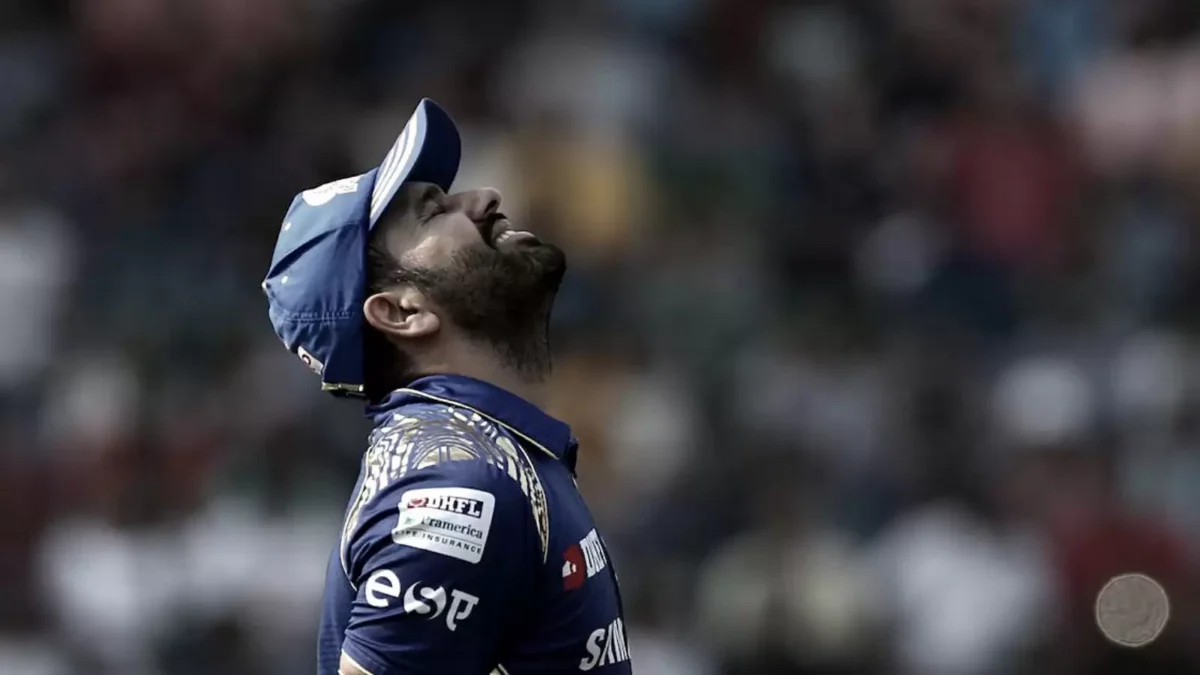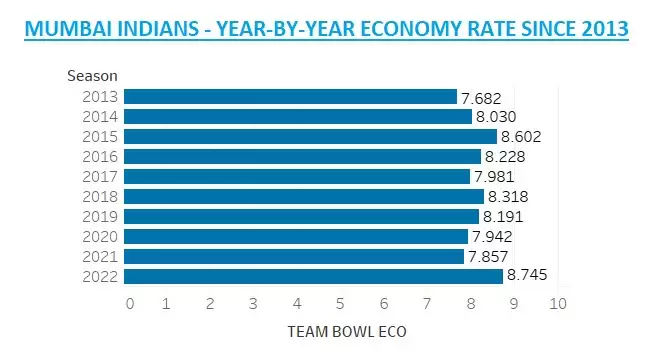
Rohit Sharma the opening batter has been an IPL failure for over six seasons worth of batting now.

12 innings, 404 runs at 36.72 with a strike-rate of 147.98. When most Indian batters outside a select few were struggling to find their feet in T20 cricket, Rohit Sharma nailed his maiden IPL season for Deccan Chargers.
At a tender age of 21, Rohit, who had played a few critical knocks in India’s T20 World Cup win a year before, was acing it in what would turn out to be the game’s toughest domestic T20 league.
Budget for the infant stage of defensive bowling skills, and that is still a season that had Rohit end in an elite club of Gautam Gambhir, Virender Sehwag, Suresh Raina and MS Dhoni among the most prolific and explosive Indian batters for IPL 2008. He struck at a better rate than Gambhir and averaged higher than Sehwag and Dhoni.
And Rohit did so in a losing team that still holds the record for the most lopsided win/loss ratio in an IPL season, with only two wins over 14 league matches. Shining above your teammates’ struggles has been one of cricket’s toughest challenges. Rohit did that with a level of authority and class beyond his age. Only a genius top-order aggressor in Adam Gilchrist scored more runs for the Chargers. But even he carried a strike-rate 10 runs shy of India’s finest young talent.
The 2008 season should’ve propelled Rohit into a bonafide IPL great with an incredible record under his belt. As he stands today, however, Rohit Sharma has been an IPL failure for over six seasons worth of batting. The Mumbai Indians (MI) skipper has undergone one lacklustre IPL season after another, with the shine of multiple trophies under his captaincy hiding Rohit’s own gloomy performances with the bat.
The IPL 2016 was the last time Rohit Sharma averaged higher than 30 while also carrying a strike-rate past 130. Since IPL 2017, He is averaging 25.37 with a strike-rate of 126.49 for MI over 84 innings, which include only 11 scores of 50 or more – nearly 8 innings per one half-century
In his overall IPL career, Rohit has made 40 scores of fifty or more, but that is from 222 innings. If one filters on the lookout for seasons that had Rohit averaging above 30 with a SR over 130, he would find only four such campaigns with the bat. Three of those have come since 2013, when Rohit became an MI captain, and thus integral to their set-up.
Given that the diaspora of fans is vastly more knowledgeable now, these numbers are quite prevalent in discussions over social media. It isn’t that fans aren’t aware of the same, just that with Rohit, it’s his name and class that reverberates around more than the performances during an IPL season. Enamoured by the graceful nature of his batting, we’ve tended to look past a sustained dip in his performances and never really asked for MI to put their opening batter under scrutiny.
That needs to change, though, and the time for the change is now. With MI approaching a transition phase and going through a disastrous season on the field, names such as Ishan Kishan, and Kieron Pollard would be thrown under the scanner. But that would be an exercise done without addressing the real elephant in the room.
Rohit’s IPL 2022 struggles were initially attached to the excess pressure he may have been carrying because of Kishan’s pedestrian run inside the powerplay overs at the other end while trying to cover up for the weakest bowling arsenal that MI has ever compiled.
But if Rohit was forced to take extra risks, why did he finish with a strike-rate of 120.18 on good batting pitches? And, if he is a high-class player with an expanded range, why then did he average only 19.14 with the best score of 48? Over a healthy sample size of 14 innings, Rohit averaged 24.33 versus pace with a strike-rate of 121.66 in IPL 2022. The corresponding numbers for spin were even more abysmal: 6 innings, 49 runs, avg 9.80, SR 113.95.
Since 2017, Rohit has made his runs against spin in the IPL at a per over scoring rate of 6.93, which rises only to 7.97 against fast-bowling. He averages 28.19 versus the seamers and even worse, 21.93 against the spin.
Filter deeper, and the record takes a darker, worrying turn against the two biggest threats for T20 batters: fast-bowling above 140 clicks and quality wrist spin. The speed data for fast-bowling is available since 2020, while we will gauge Rohit’s wrist spin proficiency, or lack of, from 2017.
Against wrist spin in the given timeframe, Rohit has had a strike-rate of 116.99 while averaging 19.73 over 45 innings. Known for the ‘time’ he has up his sleeves against fast-bowling, he has just about a decent strike-rate of 131.4 for 118 recorded balls faced above the 140 kph from IPL 2020. With Rohit, especially with him starting inside the powerplay, you’d expect that to be in upwards of 140-150.
Also Read: Virat Kohli — When will RCB address the elephant in the room?
Despite his failed state as an IPL batter, an argument that gets presented in favour of MI’s vote of confidence on Rohit is his legacy as skipper, with an unprecedented five IPL titles won. Captaincy is by no means an easy job, and Rohit would’ve had his influence on the man-management side of things.
But it’s time we ask ourselves did MI achieve their trophies with any sense of dependence on Rohit Sharma the batter? And, given their robust scouting set-up, couldn’t they have replicated their success under any other performing leader?
While man-management skills are unquantifiable, a statistical means to assess MI’s lack of dependence on Rohit’s batting is to gauge his year-by-year rate of scoring in comparison to the numbers compiled by the rest of the MI batters and the runs conceded by their bowling unit to the opposition since 2013.
As with Virat Kohli in an earlier piece, the idea is to find whether Rohit has kept MI in line for a desired score, be it batting first or chasing. Or has he been conceding too much ground to the opposition even as the rest of the batting unit has taken the load nicely?
Below is a comparison of Rohit Sharma’s year-by-year rate of scoring per over as opposed to that of the rest of the Mumbai Indians batters. Even though he failed to maintain healthy averages and strike-rates over a length of time, Rohit was still not as much of a liability for the first four seasons in MI colours, carrying a strike-rate better than his teammates till IPL 2016.
The decline truly began from the 2017 season, when he has not only had a poor average but also consistently scored below the rate at which the rest of the MI batters have gone. In only one of the IPL seasons since – in IPL 2021 – has Rohit carried a marginally better scoring rate than his teammates. That is simply not good enough for MI’s most entrusted incumbent, given he has luxury of role clarity and assurance of a spot as skipper.

A further comparison with the runs given by MI’s bowling attack per over is quite revealing, too. In no single season since the start of IPL 2017 has Rohit swum above his team’s per-game bowling expenditure, never really allowing MI to cover for their bowling and recover the ground conceded to the opposition.
In his overall MI career, there have been only two seasons – in 2013 and 2015 – where Rohit has done that, which, again, talks of a huge liability, for winning matches is basically outscoring the opposition. Rohit has failed to do so in seven of his nine seasons for MI now.

With his range exposed, and returns so alarmingly poor, you wonder why then MI retained Rohit as their heftiest pre-auction pick for INR 16 crores. It can’t be for captaincy, right? For clearly, as a tenth-place finish reinforced, the influence of Rohit Sharma the captain is directly relative to the richness of the resources around him, especially on the bowling front.
MI had a tournament ER of 7.85 last year, with Trent Boult, Krunal Pandya, Nathan Coulter-Nile, Rahul Chahar along with Jasprit Bumrah combined to form one of the better bowling units of the IPL. With that luxury gone, and the non-Bumrah end losing all the steam, oppositions scored at 8.74 an over against the same team.
No amount of captaincy and man-management skills were going to help MI cover for such a genuine lack of quality on the bowling front, especially with a longstanding IPL failure at the top of their batting order.